|
Brian's Guitar from Conception to Birth
or How to Build a Guitar in 62 Easy Steps! |
|
48
The Color Coat |
 |
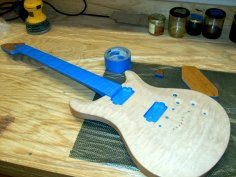 |
 |
It’s a good idea to do your finishing in a separate room from your
woodworking and all the associated sawdust. If you don’t have a
spare space, don’t apply finish on the same day you’re cutting wood.
You also need to make something to hold your guitar off the table so
you’re not laying it down on the newly applied finish. This doesn’t
have to be anything exotic. We used two screws driven through a
piece of scrap wood. The screws are spaced so that the points
support the inside ledge of the battery compartment where they won’t
gouge or scratch the finish. Now tape off everything you don’t want
colored. Our neck will remain natural, so we taped it off. You also
want to tape off the insides of the pickups cavities (the bottoms
and sides) and all the other penetrations and holes. Tape off the
control cavity and the battery compartment if you have one. You will
not want a build up of finish getting into all those nooks or your
knobs and other hardware may not fit right later.
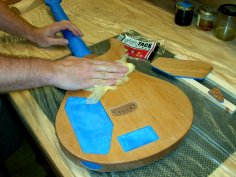 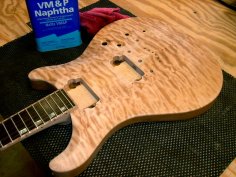 Clean
the guitar thoroughly. Wipe it down with naptha or mineral spirits
on a clean rag and follow that up with a vacuum to suck out the
remaining dust. Avoid blowing out the dust as that will just kick
the dust up into the air where it may decide to fall back down onto
your newly applied (and sticky) finish. Follow that up with a
thorough rub down with a tack cloth to remove any remaining dust. Clean
the guitar thoroughly. Wipe it down with naptha or mineral spirits
on a clean rag and follow that up with a vacuum to suck out the
remaining dust. Avoid blowing out the dust as that will just kick
the dust up into the air where it may decide to fall back down onto
your newly applied (and sticky) finish. Follow that up with a
thorough rub down with a tack cloth to remove any remaining dust.
|
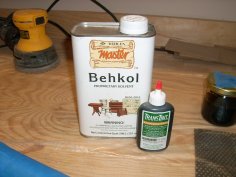 Now
that you’re ready, it’s time to throw on some color. I believe dyes
are a better finish over stains. Dyes have smaller color particles
which can better get into tighter grains like maple resulting in a
more even coat. They are available in a whole rainbow or colors
(including reds, blues, greens, etc.). They offer better control
over concentrations and dilutions since you mix it yourself. We used
TransTint dye in Golden Brown mixed with denatured alcohol as the
solvent (Bekhol is the brand name). From our test pieces we chose to
use a very diluted blend to achieve a very light brown overall tone.
Sorry, we did not keep the exact dye to solvent ratio as we got
there through a some trial and error. We would not be able to
duplicate it exactly, but we made sure we had enough to color the
whole guitar. About 4 ounces of the mixture would be enough, but
make a little more just in case. Now
that you’re ready, it’s time to throw on some color. I believe dyes
are a better finish over stains. Dyes have smaller color particles
which can better get into tighter grains like maple resulting in a
more even coat. They are available in a whole rainbow or colors
(including reds, blues, greens, etc.). They offer better control
over concentrations and dilutions since you mix it yourself. We used
TransTint dye in Golden Brown mixed with denatured alcohol as the
solvent (Bekhol is the brand name). From our test pieces we chose to
use a very diluted blend to achieve a very light brown overall tone.
Sorry, we did not keep the exact dye to solvent ratio as we got
there through a some trial and error. We would not be able to
duplicate it exactly, but we made sure we had enough to color the
whole guitar. About 4 ounces of the mixture would be enough, but
make a little more just in case.
|
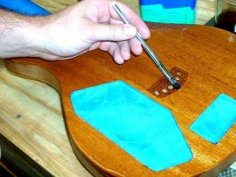 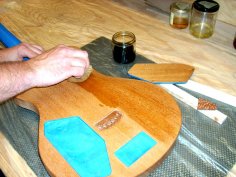 Get
a smooth, clean rag and fold it over a few times to give the dye
something to soak in to. Turn the guitar face down to work on the
back first. Load up the rag and coat the surface. Since the alcohol
dries fairly quickly, you’ll want to work fast. Try not to leave any
puddles which will soak in at a different rate. Use a small brush to
get into the tight areas and follow up that up with wiping those
areas with a rag. Get
a smooth, clean rag and fold it over a few times to give the dye
something to soak in to. Turn the guitar face down to work on the
back first. Load up the rag and coat the surface. Since the alcohol
dries fairly quickly, you’ll want to work fast. Try not to leave any
puddles which will soak in at a different rate. Use a small brush to
get into the tight areas and follow up that up with wiping those
areas with a rag.
|
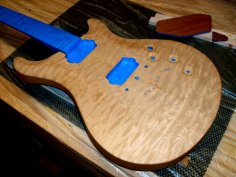 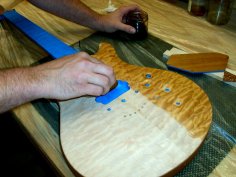 Flip
the guitar over without touching the new finish and rest the guitar
on your “screw jacks” with the neck supported by a block of wood.
Coat the sides first, then move to the front surface the same way.
As long you work quickly, the dye is a little forgiving since you
can wipe over an area several times without puddling and getting
dark spots. Double-check everything so that you wipe up any runs.
Don’t forget to color your headstock, control cavity cover, and
truss rod cover (if you made any of those from wood like we did).
One coat is all it takes. Let it dry overnight. When you first apply
the dye, the guitar will look spectacular, but it will dry down to a
more muted tone. It would be nice to keep that spectacular “wet
look” you see in the first photo above. That’s what the following
coat will get you; the oil coat. Flip
the guitar over without touching the new finish and rest the guitar
on your “screw jacks” with the neck supported by a block of wood.
Coat the sides first, then move to the front surface the same way.
As long you work quickly, the dye is a little forgiving since you
can wipe over an area several times without puddling and getting
dark spots. Double-check everything so that you wipe up any runs.
Don’t forget to color your headstock, control cavity cover, and
truss rod cover (if you made any of those from wood like we did).
One coat is all it takes. Let it dry overnight. When you first apply
the dye, the guitar will look spectacular, but it will dry down to a
more muted tone. It would be nice to keep that spectacular “wet
look” you see in the first photo above. That’s what the following
coat will get you; the oil coat. |